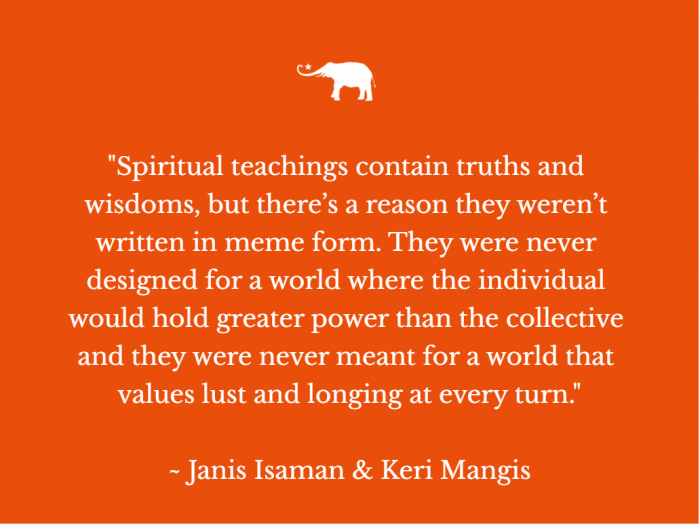“Why do you care so much? They’re only things,” my now-former yoga colleague challenged me.
My commercial yoga partnership had collapsed and I wanted to take the books and bookshelf that I had loaned to the business home with me.
I retorted: “Yes, but they’re my things, and I want them back.”
It would’ve been easier and less stressful to leave these items of sentimental value behind and never look back.
As a yogini practicing non-attachment, I wasn’t “supposed” to care about material things.
Yoga philosophy would’ve chided me that I’d gotten too attached to the material world. Spiritual teachers—maybe even myself if this weren’t happening to me—would’ve suggested that if I were really yogic, I could’ve just walked away and taken nothing with me.
Theoretically, by even asking for these items, I wasn’t practicing the concepts of non-attachment that I’d been teaching.
But I cared, I was attached, and I couldn’t pretend otherwise.
Getting attached, desiring an outcome, leaning in, and seeking control are woven within the very cells of our human nature.
Attachment, in the spiritual sense, is about identifying ourselves with our preferences. When we are “attached,” our self-identification with what we like dictates how we look, what we choose, and how we relate to the world.
Attachment is a drive to individuate and to exercise the rights and rewards of the individual, which is the foundation of the Western culture in which we live.
Yet, the spiritual principle of non-attachment is based on the concept that we are all one, and that we suffer because we have desires of the individualized ego that are an outcome of a dualistic view: “me” versus “others.” It’s seen as a barrier to the path to enlightenment.
As the self-help industry has permeated culture, we increasingly find reminders at every corner that it’s necessary to “let go” of our attachments. After something uncomfortable has happened, the spiritual standard of non-attachment means we might hear, or say, such phrases as:
>> “Don’t get attached.”
>> “Lean back.”
>> “Let go of control.”
>> “Don’t focus on the outcome.”
The non-attachment principle is also behind phrases such as:
>> “You’ll find new friends,” we tell children when they lose their best friend.
>> “Let go of all expectations,” we remind girlfriends before they head out on a date.
>> “You’ll land somewhere better,” we tell friends who lose their job.
These memified, cheery, positive reminders imply that all we need to do in order to come to terms with mourning loss, struggling with grief, or holding unfulfilled longings is to release attachment to the outcome, experience, or idea.
Like many other spiritual concepts, “attachment” has, at times, become weaponized. At a minimum, it’s gone too far.
Healthy attachment can lead to happiness. For example, we are attached to our friends and loved ones. We are attached to the construct of freedom. And we are devastated when these things go away: we fight wars for liberty and hold funerals for the death of those who held meaning in our lives.
We can universally agree that these are healthy expressions of attachment.
Non-attachment is often used as a tool to disengage from our responsibility to the world and to each other. We might say we’re living in “equanimity,” but what we’re really doing is avoiding living in the deepest recesses of pain and in the highest planes of joy.
And, in our efforts to not be attached and practice letting go, we might too easily start letting go of people, things, and ideas that matter. In an effort to prove our non-attachment, we might even let our integrity get watered down and our values lose shape and texture.
We are living in the duality of a world that first tells us to value our freedoms and choices and then promotes individualization as a tool to propel us to earn money, hire coaches, go to the gym, and do self-inquiry and self-development work.
Then when we arrive in the self-help circles following the inevitable disappointments and losses, we are shamed for failing to internalize the holistic spiritual viewpoint that we are all connected. We are slammed, head-first, into reinforcement that this way of being is “keeping us stuck.”
So we try to navigate both worlds.
We gaslight ourselves, repeating mantras and posting sticky notes on the mirror to remind ourselves not to care about outcomes.
We try to swipe away bad dates and jobs we didn’t get by pretending we didn’t care about the outcome. We convince ourselves to “enjoy the process,” even when we don’t. We look for silver linings that don’t exist and tell ourselves that “everything happens for a reason” or “it was for the best.”
And the browbeating and confusion means that we often fall back on faking it, pretending that we’re not attached, when all we are really doing is losing the connection to our authentic selves.
When I was a vegetarian, I once told someone I still occasionally craved chicken wings. And he said: “Then eat them. Because until you do, you will be plagued by that craving.”
This concept applies to so much of the spiritual world. When we are trying to be or behave a certain way, we are not, actually, that way. In other words, I wasn’t really a vegetarian, because not all of me had accepted it.
“Fake it ‘til you make it,” is a phrase we’ve heard endlessly about this issue. For example, if you’re not content, pretend you are and reality will follow. If you’re not yet joyful, pretend, and it will soon be yours (which is the basic concept of manifesting).
I’ve never understood how any amount of “faking it” ever leads to authenticity.
Yet, we are told all the time to do just that.
It’s not useful to repeat mantras or post memes on our mirror or direct only “positive energy” in that direction. We need to believe it, and internalize it.
Relationships hurt. Losses hurt. It’s not true that the way to prevent the pain is to remain detached. Nor is it true that the fault lies in our attachment.
In the loss of my business, I couldn’t pretend that my material belongings didn’t matter, because that’s all it would’ve been—a pretense.
I claimed my attachment, and then fought for, and received, my things back. In doing so, I boosted my sense of self, strengthened my voice, and regained some lost power. None of that could’ve happened had I remained staunchly observant of the practice of non-attachment.
Spiritual teachings contain truths and wisdoms, but there’s a reason they weren’t written in meme form. They were never designed for a world where the individual would hold greater power than the collective and they were never meant for a world that values lust and longing at every turn.
Can we reinvent what “attachment” means, and question whether we ought to strive for such idealized “non-attachment” in the modern world?
Rather than focusing on non-attachment, can we embrace the humanness and gifts of attachment, and practice authenticity and discernment? By doing so, we can:
>> Accept that attachment can lead to pain, but also that pain leads to opening.
>> Recognize that attachment leads to growth.
>> Observe that attachment can result in suffering, but also that suffering brings us into our shared humanity.
>> Honor that getting attached, losing, and letting go are part of what it means to be human, and no amount of faking humanity will bring us there.
>> Embrace that attachment can also lead to more fulfilling and healthier relationships.
>> Learn to process and acknowledge our real feelings.
Any spiritual teaching that makes us feel separated from ourselves, where we gaslight ourselves and try to minimize our realities, needs to be looked at.
Clinging to belongings and rigidly demanding we get what we want is not healthy. But a modern concept of non-attachment means fluidity, resilience, and living within an individualized culture.
It requires learning the emotional tools to help us process disappointments and pain, looking at a friend and telling them how much losing the business hurt, and learning to process the loss.
It means embracing more and more of our humanity, rather than denying that we have it.
It means using our cravings, desires, and attachments to trace our way back to our truest self, not beating ourselves up about having them.
It means harnessing suffering as a path to getting closer to our own truth and closer to the roots of healing.
And most importantly: if we are going to feel true non-attachment, it’s not going to be through willpower. We can only arrive at it through authentic learning and exploration.
We cannot fake it through memes, Post-it notes, or positive mantras.
~


 Share on bsky
Share on bsky





Read 40 comments and reply